 |
CUSTOMER FOCUSED PROJECT MANAGEMENT:Threshold Attributes |
| << PRINCIPLES OF TOTAL QUALITY:EMPOWERMENT, COST OF QUALITY |
| QUALITY IMPROVEMENT TOOLS:Data Tables, Identify the problem, Random method >> |
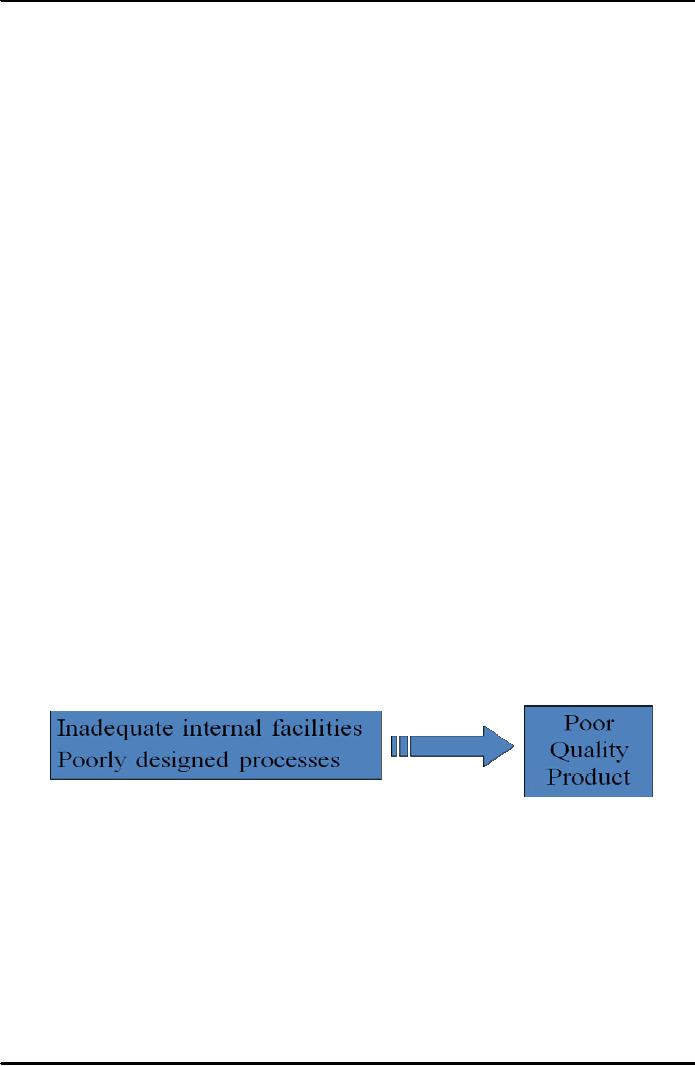
Project
Management MGMT627
VU
LESSON
37
CUSTOMER
FOCUSED PROJECT
MANAGEMENT
BROAD
CONTENTS
Who
is customer?
Key
Goals for Businesses
Type
of customers
Customer
Driven Project
Organizations
Customer
identification
Kano
Model
Customer
Satisfaction Measurement
CRM
(Customer Relationship Management)
Gathering
Customer Information
Four
Steps to Quality Customer
Service
37.1
Who
is a customer in any
project?
World
class projects and organizations are
obsessed with meeting and
exceeding customer
expectations.
Firms should learn to have "customer
focused projects", often in
response to
competitive
crises. Customers in any
project refer to:
1.
Any individual or group that
receives and must be satisfied
with the work product or
output
of
a process.
2.
Individual or group whose
request a process is intended to
fulfill.
3.
Anyone who is impacted by the product or
process.
Looking
at your project organization
from you customers' point of
view and "improving
processes"
to enable you to meet and
exceed your customers' expectations is the
only way to
achieve
quality.
It
important to meet customer expectations
as it is the prime responsibility of
every organization
to
meet the needs of its
customers. Understanding of one's
customers leads to
customer
satisfaction.
Japanese relate quality to
customer satisfaction.
Figure
37.1: Importance
of Customer Satisfaction (CS) in Project
Management
37.2
Key
goals for
businesses:
Following
are the four key goals for
any business:
1.
Satisfy
customers
2.
Achieve
higher customer satisfaction
than competitors
3.
Retain
customers in long run
4.
Gain
market share
268
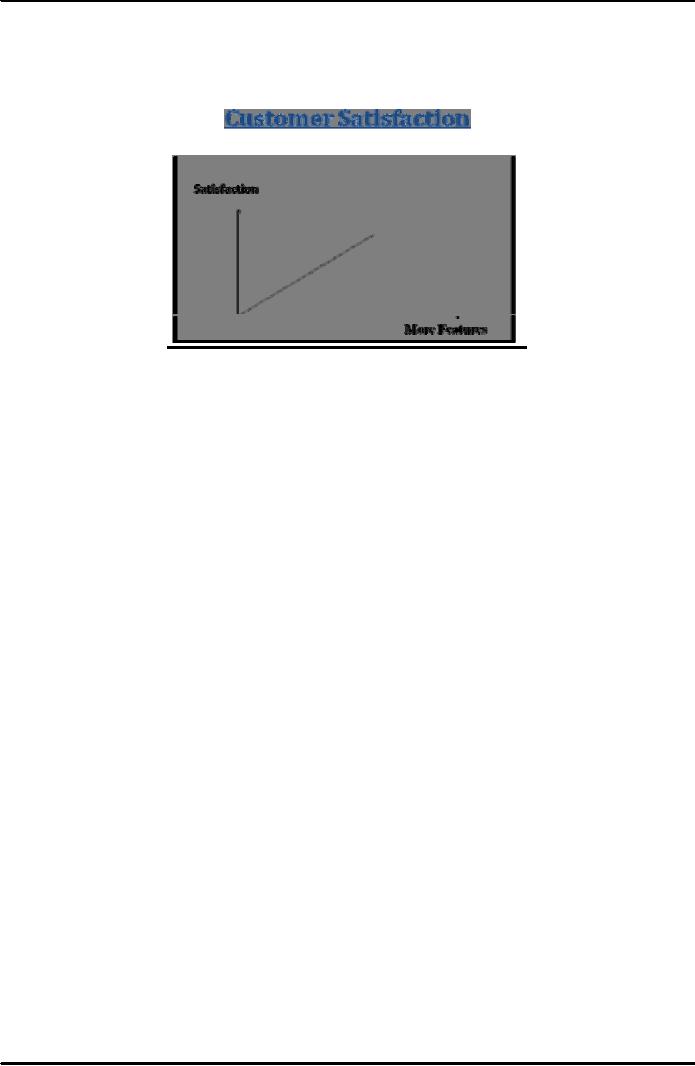
Project
Management MGMT627
VU
To
achieve aims and goals, a business
must deliver ever-improving
value to its
customers.
Value
refers to "quality related to price". It
is important as consumers no longer
buy solely on
the
basis of price.
Figure
37.2: Customer
Satisfaction
37.3
Types
of Customers:
�
Primary:
"Direct
receiver of output of the process"
(bank loan seeker, lab
test report receiver). It
is
the
source of product and
process requirement.
�
Secondary:
Secondary
customers are from "outside
of process" boundaries, who also
receive any
process
output, but not reason
for "process' existence"
(bank's head office
receiver
secondary
output)
�
Indirect:
When
original boundaries do not receive
process output directly but
are affected if
process
output
is incorrect or late (logistic
department)
�
External
Customers:
Those
who are located outside the
organizational boundaries, receive end
product or service
but
is not the actual user. (Power supplier
for computers manufacturing,
distributors)
�
Consumer
End User:
This
refers to the final user of the product.
Sometimes the external customers
and
consumers
are the same.
�
Intermediary:
In
between producer and end user
(Transporter).
269
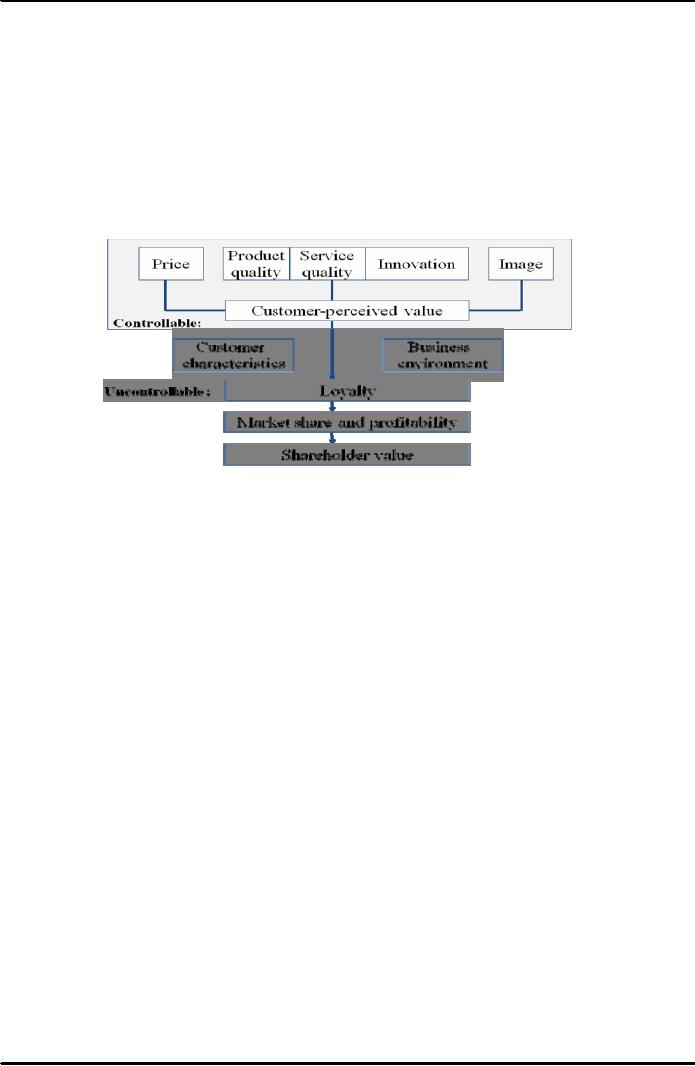
Project
Management MGMT627
VU
�
False:
When
a process that performs activities
that do not add value to
product or service.
Inspectors
doing 100 % inspection. It
needs to be eliminated.
�
Internal:
Next
person to whom product
passed on for further
processing. His requests
must be met,
but
not at cost of external
customers.
37.4
Customer-Driven
Project Organizations:
Figure
37.3: Customer
Value Package
If
competitors offer better choices
for similar price, consumers
naturally select package
with
highest
"perceived quality".
37.5
Customer
Identification:
37.5.1
Fundamental Questions in Identifying
Customers:
Identifying
customers begins with asking
some fundamental questions:
�
What
products/services are produced?
�
Who
uses products/ services?
�
Do
employees call/ write to/
answer questions for?
�
Supplies
inputs
37.5.2
Importance of
Identifying Customer
Types:
Every
customer type, source of
product, product requirements must be
identified and
process
effectiveness must be measured.
Information
on what satisfies customer, and what
improvements are necessary. It
comes
from
lost, prospective, and competitors'
customer, who provide useful
insights.
37.6
Kano
Model:
The
Kano Model of Customer (Consumer)
Satisfaction classifies product
attributes based on
how
they are perceived by
customers and their effect
on customer satisfaction.
These
classifications
are useful for guiding
design decisions in that they indicate
when good is good
enough,
and when more is better.
270
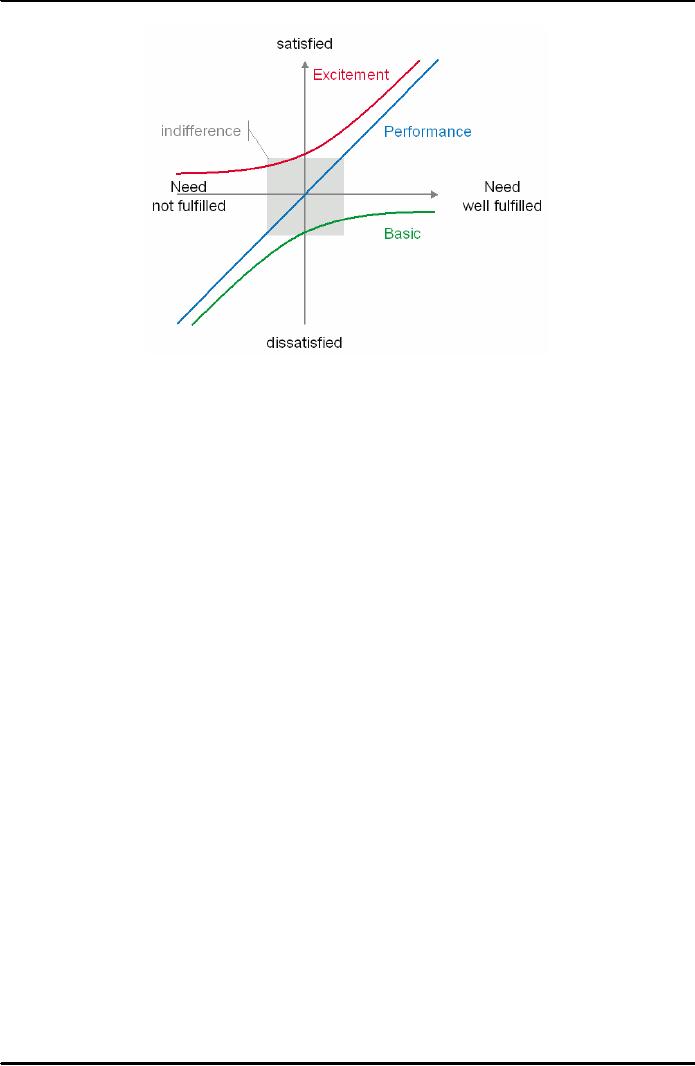
Project
Management MGMT627
VU
Figure
37.4: Analyzing
Customer Satisfaction Data Kano
Model
Project
activities in which the Kano
Model is useful:
1.
Identifying customer
needs
2.
Determining functional
requirements
3.
Concept development
4.
Analysing competitive products
Other
tools that are useful in
conjunction with the Kano
Model:
1.
Eliciting Customer
Input
2.
Prioritisation Matrices
3.
Quality Function
Deployment
4.
Value Analysis
Introduction
The
Kano Model of Customer
satisfaction (Figure 37.4)
divides product attributes
into three categories:
threshold,
performance, and excitement. A competitive
product meets basic
attributes, maximises
performances
attributes, and includes as many
"excitement" attributes as possible at a
cost the market
can
bear.
Threshold
Attributes
Threshold
(or basic) attributes are
the expected attributes or "musts" of a
product, and do not provide
an
opportunity
for product differentiation.
Increasing the performance of these
attributes provides
diminishing
returns in terms of customer
satisfaction; however the absence or
poor performance of these
attributes
results in extreme customer
dissatisfaction. An example of a
threshold attribute would
be
brakes
on a car.
Kano
Model Analysis
Threshold
attributes are not typically
captured in QFDs (Quality Function
Deployment) or other
evaluation
tools as products are not rated on the
degree to which a threshold
attribute is met, the
attribute
is either satisfied or
not.
271

Project
Management MGMT627
VU
Performance
Attributes
Performance
attributes are those for
which more is generally better, and
will improve customer
satisfaction.
Conversely, an absent or weak performance
attribute reduces customer
satisfaction. Of the
needs
customers verbalise, most
will fall into the category
of performance attributes. These
attributes
will
form the weighted needs against
which product concepts will
be evaluated. The price for
which
customer
is willing to pay for a
product is closely tied to performance
attributes. For
example,
customers
would be willing to pay more
for a car that provides them
with better fuel
economy.
Excitement
Attributes
Excitement
attributes are unspoken and unexpected by
customers but can result in
high levels of
customer
satisfaction, however their
absence does not lead to
dissatisfaction. Excitement attributes
often
satisfy
latent needs real
needs of which customers are
currently unaware. In a competitive
marketplace
where
manufacturers' products provide similar
performance, providing excitement
attributes that
address
"unknown needs" can provide a
competitive advantage. Although they have
followed the
typical
evolution to a performance then a
threshold attribute, cup holders were
initially excitement
attributes.
Other
Attributes
Products
often have attributes that cannot be
classified according to the Kano
Model. These
attributes
are
often of little or no consequence to the
customer, and do not factor into
consumer decisions. An
example
of this type of attribute is a
plate listing part numbers
can be found under the hood
on many
vehicles
for use by repairpersons.
Application
of the Kano Model
Analysis
A
relatively simple approach to applying
the Kano Model Analysis is to
ask customers two
simple
questions
for each attribute:
1.
Rate your satisfaction if the product
has this attribute?;
and
2.
Rate your satisfaction if the product
did not have this
attribute?
Kano
Model Analysis
Customers
should be asked to answer
with one of the following
responses:
A)
Satisfied;
B)
Neutral (Its normally that
way);
C)
Dissatisfied;
D)
Don't care.
Basic
attributes generally receive the
"Neutral" response to Question 1 and the
"Dissatisfied" response
to
Question 2. Exclusion of these attributes
in the product has the
potential to severely impact
the
success
of the product in the marketplace.
�
Eliminate
or include performance or excitement
attributes that their
presence or absence
respectively
lead to customer dissatisfaction.
This often requires a trade-off analysis
against
cost.
As Customers frequently rate most
attributes or functionality as important,
asking the
question
"How much extra would
you be willing to pay for
this attribute or more of
this
attribute?"
will aid in trade-off decisions,
especially for performance attributes.
Prioritisation
matrices
can be useful in determining
which excitement attributes
would provide the
greatest
returns
on Customer satisfaction.
�
Consideration
should be given to attributes
receiving a "Don't care"
response as they will
not
increase
customer satisfaction nor
motivate the customer to pay an
increased price for
the
product.
However, do not immediately
dismiss these attributes if
they play a critical role to
the
product
functionality or are necessary
for other reasons than to
satisfy the customer. The
272
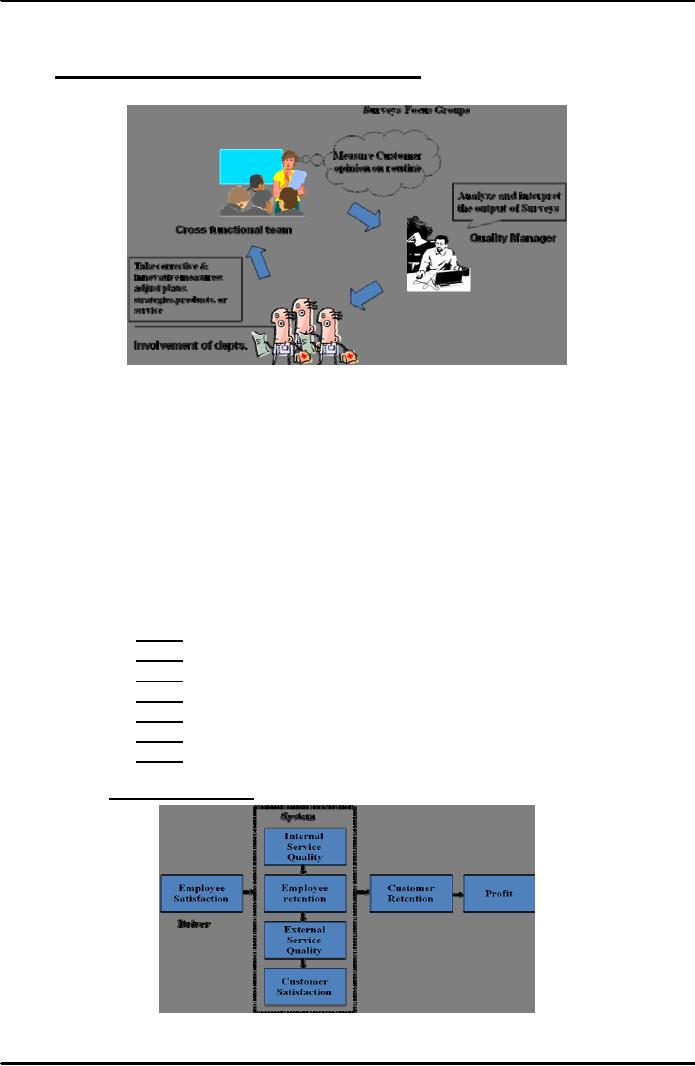
Project
Management MGMT627
VU
information
obtained from the Kano Model
Analysis, specifically regarding
performance and
excitement
attributes, provides valuable
input for the Quality
Function Deployment
process.
37.7
CUSTOMER
SATISFACTION MEASUREMENT:
Figure
37.5: Measuring
Customer Satisfaction
Levels
37.7.1
Methods of Customer Retention:
Following
are the methods for
retaining customers:
�
Establish
honest relationship and empathize
�
Reward
loyalty (airline's frequent
flyer)
�
Reward
usage (Coupons, credit points,
preferential treatment)
�
Provide
unpaid service (free product
targets, after sales
service)
37.7.2
Seven Steps to Customer Satisfaction
System:
�
Step
1: Total management
commitment
�
Step
2: Get to know your
customers
�
Step
3: Develop "performance and process
standards" of service quality
�
Step
4: Hire, train, and compensate
good staff
�
Step
5: Reward service accomplishments
�
Step
6: Stay close to your
customers
�
Step
7: Work towards continuous improvement in
"service quality performance
37.7.3
Customer Defections:
Figure
37.6: Customer
Retention and Profitability
273
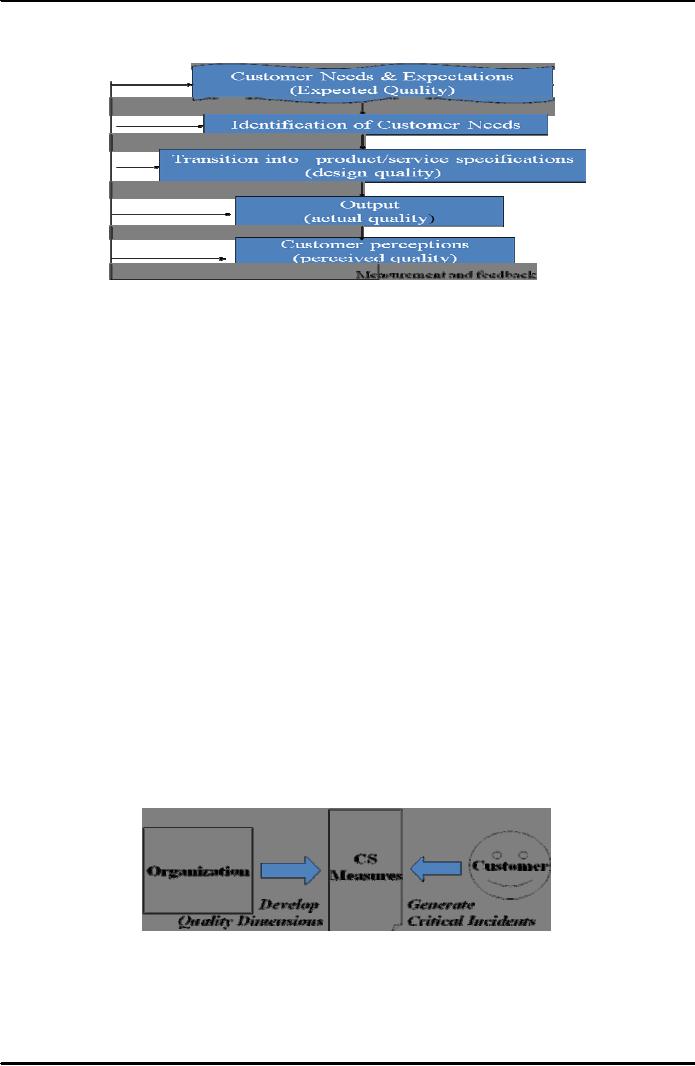
Project
Management MGMT627
VU
Figure
37.7: Customer
Driven Quality Cycle
1.
Leading practices for
profitability
and market share must
understand linkages
between
voice of customer and design, production,
and delivery processes.
2.
Ensures that no critical requirements
fall through cracks and
minimizes potential
gaps
between expected quality and actual
quality.
3.
Make commitment to customer
that promotes trust and confidence in products
and
services.
4.
Must have effective Customer
Relationship Management (CRM)"
processes by
which
customer can easily seek
assistance, comment, complain and receive
prompt
resolution
of their concerns.
37.7.4
Must measure Customer
Satisfaction:
1.
Compare results relative to
competitors
2.
Use information to
evaluate
3.
Improve internal
processes
37.7.5
Methods of Measuring Customer Satisfaction:
There
are the following two
methods of measuring customer
satisfaction:
1.
Quality Dimension
Development
2.
Generate Critical Incidents
Figure
37.8: Methods
of Measuring Customer
Satisfaction
274
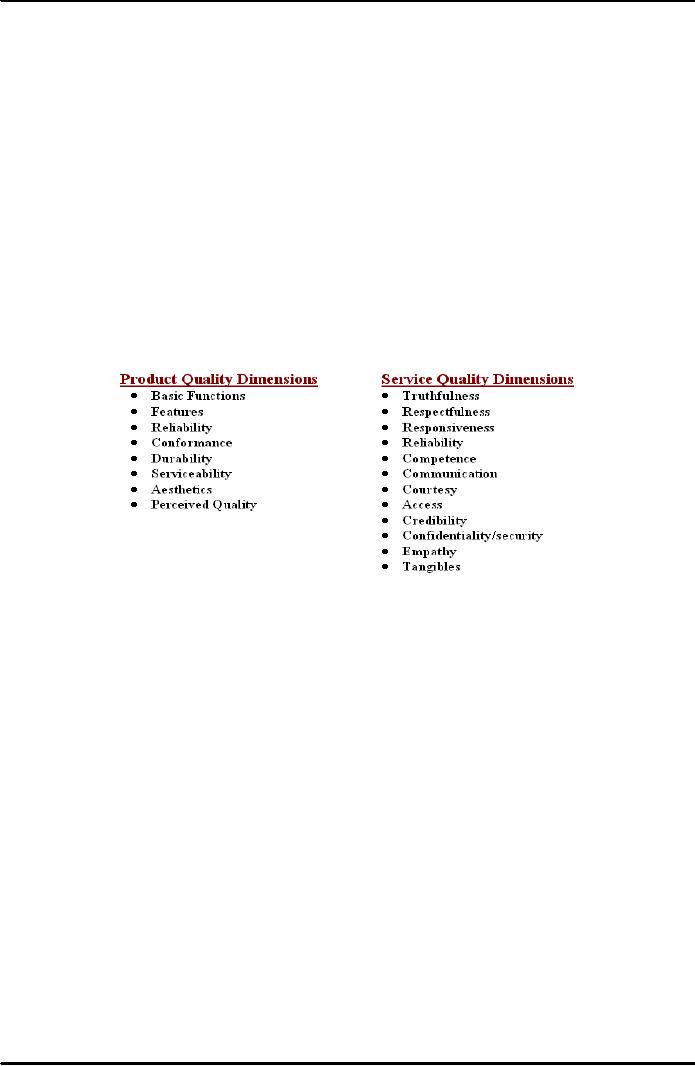
Project
Management MGMT627
VU
37.7.5.1Quality
Dimensions Development
Method:
Step
1: Creating list of quality dimensions
(Table 37.1):
a)
Read professional literature and
enlist quality dimensions
b)
Generate list from personal
experience
Step
2: Write definitions of each
dimensions:
a)
Definition can be in general
terms
Step
3: Develop specific examples
for each quality
dimension:
a)
Examples:
Specific-reflecting service or
product
b)
Examples:
Specific
behaviors
of
providers
c)
Declarative
statements
Table
37.1: Quality
Dimensions
37.7.5.2Five
Key Dimensions of Service
Quality:
1.
Reliability:
�
Ability
to provide what was promised,
dependably and
accurately.
�
Customer
service representatives respond in promised
time.
�
Following
customer instructions.
�
Providing
error free invoices and
statements.
�
Making
repairs correctly first
time.
�
Assurance:
Knowledge and courtesy of
employees.
�
Their
ability to convey "trust and
confidence".
�
Ability
to answer questions.
�
Having
capabilities to do necessary
work.
�
Monitoring
credit card transactions to
avoid possible fraud.
�
Being
polite and pleasant during
customer transactions.
2.
Tangibles:
�
Physical
facilities
�
Equipment
and appearance of persons
include:
o
Attractive
facilities
o
Appropriately
dressed employees
o
Well
designed forms that are easy to
read and interpret
275
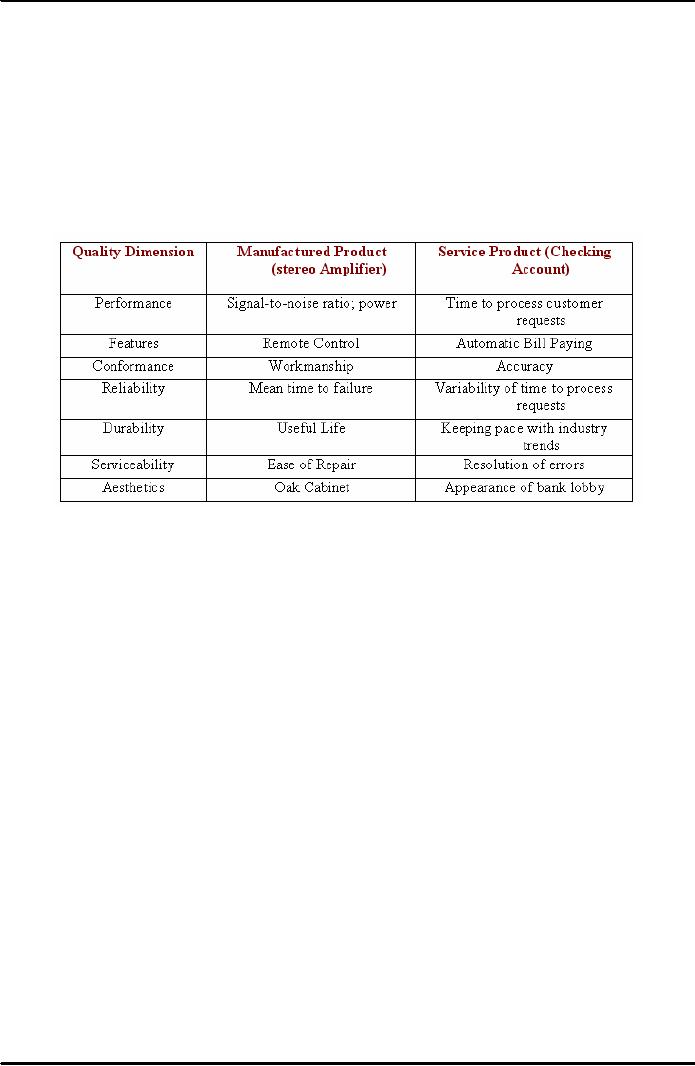
Project
Management MGMT627
VU
3.
Empathy:
�
Degree of
Caring and include attention
provided to customer
�
Explaining
"Tech Jargon" in: layman's
language
�
Recognizing
regular customers by
name
4.
Responsiveness:
�
Willingness
to help customer and provide
prompt service. For
example:
o
Acting
quickly to resolve problems
o
Promptly
crediting returned
merchandise
o
Rapidly
replacing defective products
Table
37.2: Quality
Dimensions of a Manufactured Product and
Service
5.
Timeliness of Support:
�
They
completed the job when expected
�
They
met my deadlines
�
They
finished their responsibilities
within stated time
frame
�
The
project was completed on
time
6.
Responsiveness of Support:
�
They
were quick to respond when I
asked for help
�
They
immediately helped me when I
needed help
�
I
waited a short period of time to get
help after I asked for
it
37.8
Customer
Relationship Management (CRM):
Customer
Relationship Management (CRM)
includes attention
to:
�
Target
and developing customer contact
employees.
�
Empowering
them to do whatever is necessary to
satisfy customers.
37.9
Gathering
Customer Information:
�
Customer
requirements called "voice of
customer":
There
are a variety of methods to
"listen" to the Voice of Customer. To do it
effectively,
information
needs to be collected about the
customer like:
a)
Needs and expectations
b)
Importance
c)
Satisfaction with company's
performance
276
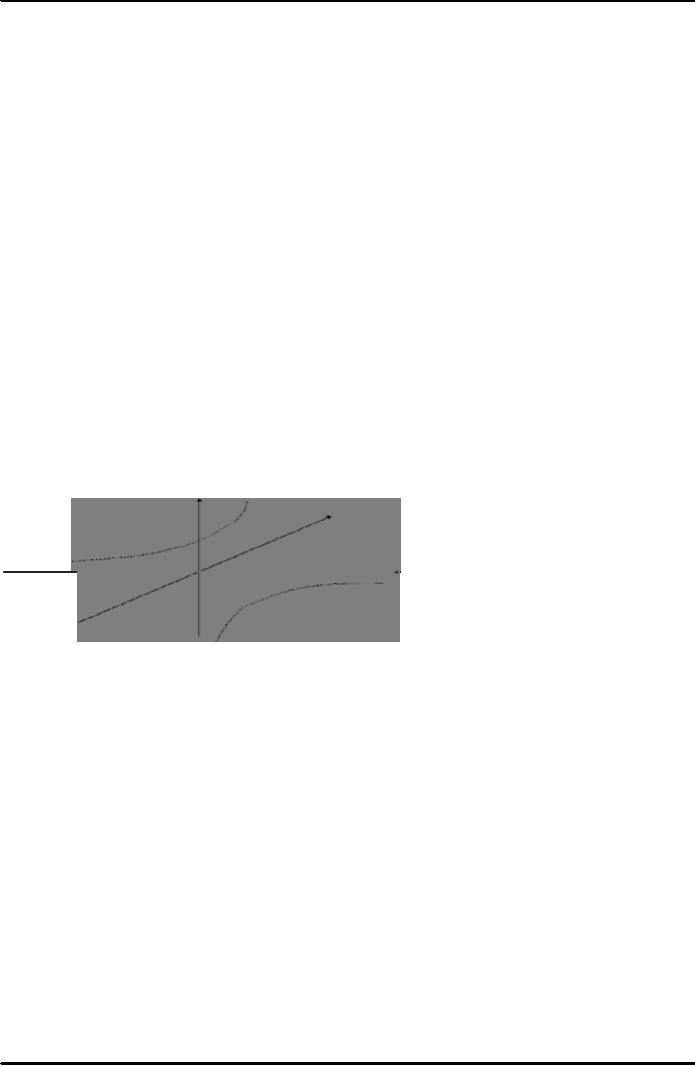
Project
Management MGMT627
VU
37.10
Four
Steps to Quality Customer
Service:
There
are the following four steps
to quality customer service:
Step
1: Send positive
attitude:
�
Product
Knowledge / command
�
Appearance
(dress, quality, cleanliness, orderliness,
etc)
�
Body
language (head, arms facial, smile,
body movement, eye contact)
�
Sound of
your voice (tone and how
you say it)
o
Face
to face
o
On
telephone (telephone skills)
�
Staying
energized
�
Empathize
(concern for customer's benefits)
Step
2: Identify needs of your
customers, guests,
clients
a)
Human Needs: (welcomed, respected,
comfortable, orderly, understood, helped,
important,
appreciated,
recognized)
b)
Timing Needs: (hold time on
telephone, waiting in office,
letter response, return
calls,
appropriate
time to meet, width and
depth of product/service
needs)
c)
Location Needs:
d)
Product Needs: (stated, unstated, basic,
delighter)
e)
Create an environment to
listen
f)
Careful Listening and
Understanding
g)
Feedback / Evaluation
Figure
37.9: Use of Kano Model to
Identify Must-be, Delighters and
One Dimensional
Qualities
Step
3: Provide for needs of your
customers, guests,
clients
�
Are
you ready to fulfill the
human, timing, location, and
product needs of the
customer?
�
Are
you capable to fulfill the
human, timing, location, and
product needs of the
customer?
�
Do
you have the required
product / service to meet the
needs of the
customer?
�
Have
you actually fulfilled the
human, timing, location, and
product needs of the
customer?
Step
4: Make sure your customers,
clients, guests return to
you
�
Make
sure you delivered both the
procedures and the personal
�
Be
sensitive to check your performance by the
outcomes before, during and
after the service
delivery
�
Handling
complaint for cases of gaps,
customers will complain
(within themselves,
gestures,
light words, strong words, strong reactions).
o
Listen
to their stated and non-stated complains
carefully
277
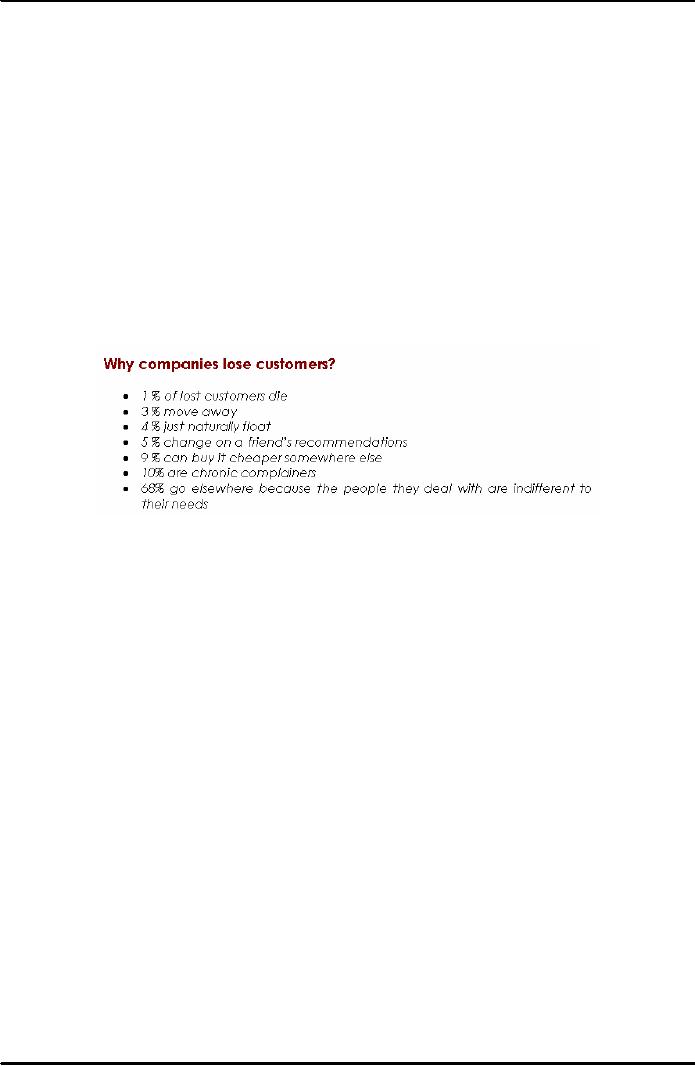
Project
Management MGMT627
VU
Empathize
o
Repeat
and confirm whether you understood
clearly
o
Apologize
genuinely
o
Acknowledge
sympathy
o
Correct
the situation
o
Identify
root-causes and prevent
recurrence
o
�
Types
of difficult customers with
whom you have to deal
nicely
o
Angry
o
Nasty
or Obnoxious
o
Demanding
o
Constant
Critic
o
Non-Stop
Talker
o
Indecisive
o
Intoxicated
o
Argumentative
�
They
are usually difficult for
their own reasons - not
because of you
Figure
37.10: Why
Companies Lose
Customers?
�
Reasons
Why Customers are Difficult:
o
Negative
experience
o
Frustrated
o
Confused
o
Satisfy
their ego or
self-esteem
o
Ignored
o
Treated
poorly
o
In bad
mood
�
Get
Difficult Customers on Your
Side:
o
Do
not take it personally, hold
on to your confidence
o
Remain
calm; listen
carefully
o
Do
not just protect yourself or
your company, share his/her
grievance
o
Focus
on the problem, not the
person
o
Turn
the difficult one into a
satisfied, consider it an accomplishments
�
Take
an extra step - surprise the
customer. For example:
o
Ticket
agent: would you like me to
select a seat for your
return flight now?
o
Salesperson:
I will deliver it personally
this afternoon
o
Nurse:
Since you are awake, let me
give you a drink
o
Waiter:
may I bring extra glass of
coffee
o
Hotel
desk clerk: may I call a
cab for you
o
Mechanic:
since car will take
long, may I give you a
newspaper
o
Grocer:
may I give you help to
carry your goods
o
Bank
Cashier: may I give you
brand new notes
278
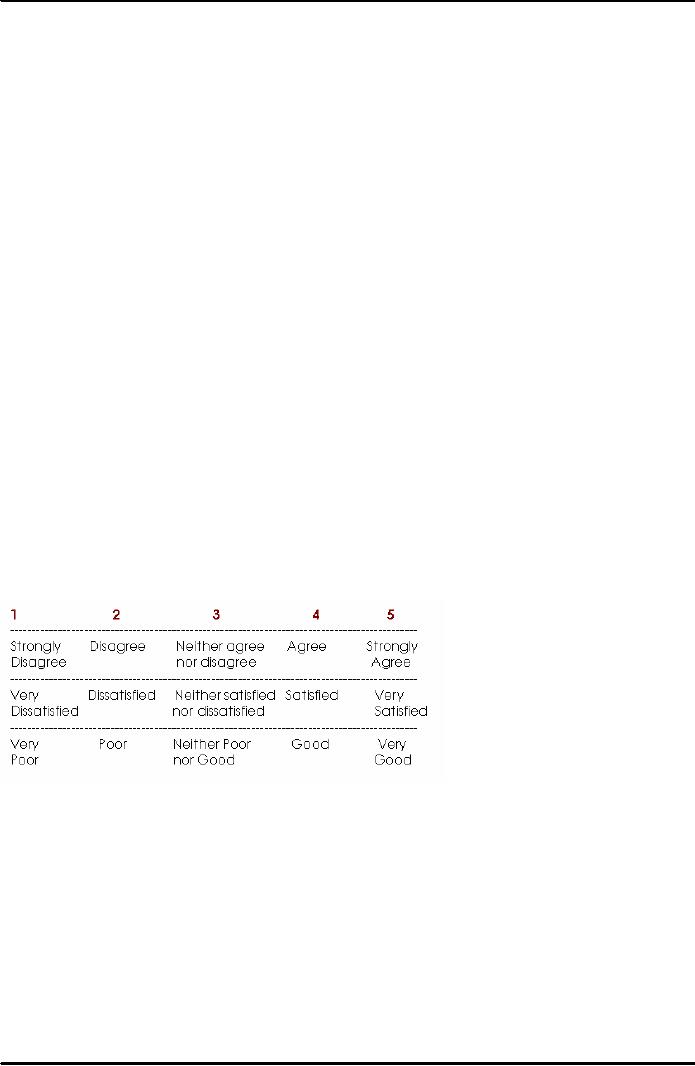
Project
Management MGMT627
VU
Re-engineer
your Customer Satisfaction into Quality
Customer Satisfaction:
�
Customer
Satisfaction Vision and
Policy
�
Customer
Satisfaction Training
�
Customer
Satisfaction Personality Grooming and
Development
�
Customer
Satisfaction Systems and
Procedures
�
Customer
Satisfaction Consistency
�
Customer
Satisfaction Measurement (e.g. customer
retention rate)
�
Develop
and regularize Customer Satisfaction
Delighters
1.
Determine Questions:
�
Be
Concise, Precise
�
Be
Direct
�
Discard
Superfluous Words
�
Be
Unambiguous
Examples:
How are these
questions?
�
The
SDO was good
�
The
bank manager listened to me and
took a short time to handle my
complaint
�
The
SDO was not available when
he was needed
�
The
SDO was available when he
was needed
�
The
staff was
courteous
2.
Response Format:
a)
Checklist
Format (yes/no)
b)
Liker-type (1-5
scale)
Table
37.3: Liker
Scale
"Introduction"
to Questionnaires:
For
example: "To better serve you, we
would like to know your
opinion of the quality of
our
service
at XYZ Company. You recently received
service from our company.
Please indicate
the
extent to which you agree or
disagree with the following
statements about the service
you
received
from the staff. Circle
the appropriate number using
the scale below.
1,
2, 3, 4, 5
279

Project
Management MGMT627
VU
Finally,
select appropriate questions; ensure
critical customer requirements are
addressed
properly.
Sampling
Some
of the common sampling techniques used
are briefly defined
below:
1.
Census
�
To gather
information from all of
customers (sample is the total
population) for
example,
doctors
response by drug manufacturers.
2.
Judgmental
Sampling
�
Use
judgment in the selection of
customers.
3.
Statistical
Sampling
�
Select
sample based on statistical
probability (rely on
chance).
It
becomes easy to
generalize,
if not biased.
280
Table of Contents:
- INTRODUCTION TO PROJECT MANAGEMENT:Broad Contents, Functions of Management
- CONCEPTS, DEFINITIONS AND NATURE OF PROJECTS:Why Projects are initiated?, Project Participants
- CONCEPTS OF PROJECT MANAGEMENT:THE PROJECT MANAGEMENT SYSTEM, Managerial Skills
- PROJECT MANAGEMENT METHODOLOGIES AND ORGANIZATIONAL STRUCTURES:Systems, Programs, and Projects
- PROJECT LIFE CYCLES:Conceptual Phase, Implementation Phase, Engineering Project
- THE PROJECT MANAGER:Team Building Skills, Conflict Resolution Skills, Organizing
- THE PROJECT MANAGER (CONTD.):Project Champions, Project Authority Breakdown
- PROJECT CONCEPTION AND PROJECT FEASIBILITY:Feasibility Analysis
- PROJECT FEASIBILITY (CONTD.):Scope of Feasibility Analysis, Project Impacts
- PROJECT FEASIBILITY (CONTD.):Operations and Production, Sales and Marketing
- PROJECT SELECTION:Modeling, The Operating Necessity, The Competitive Necessity
- PROJECT SELECTION (CONTD.):Payback Period, Internal Rate of Return (IRR)
- PROJECT PROPOSAL:Preparation for Future Proposal, Proposal Effort
- PROJECT PROPOSAL (CONTD.):Background on the Opportunity, Costs, Resources Required
- PROJECT PLANNING:Planning of Execution, Operations, Installation and Use
- PROJECT PLANNING (CONTD.):Outside Clients, Quality Control Planning
- PROJECT PLANNING (CONTD.):Elements of a Project Plan, Potential Problems
- PROJECT PLANNING (CONTD.):Sorting Out Project, Project Mission, Categories of Planning
- PROJECT PLANNING (CONTD.):Identifying Strategic Project Variables, Competitive Resources
- PROJECT PLANNING (CONTD.):Responsibilities of Key Players, Line manager will define
- PROJECT PLANNING (CONTD.):The Statement of Work (Sow)
- WORK BREAKDOWN STRUCTURE:Characteristics of Work Package
- WORK BREAKDOWN STRUCTURE:Why Do Plans Fail?
- SCHEDULES AND CHARTS:Master Production Scheduling, Program Plan
- TOTAL PROJECT PLANNING:Management Control, Project Fast-Tracking
- PROJECT SCOPE MANAGEMENT:Why is Scope Important?, Scope Management Plan
- PROJECT SCOPE MANAGEMENT:Project Scope Definition, Scope Change Control
- NETWORK SCHEDULING TECHNIQUES:Historical Evolution of Networks, Dummy Activities
- NETWORK SCHEDULING TECHNIQUES:Slack Time Calculation, Network Re-planning
- NETWORK SCHEDULING TECHNIQUES:Total PERT/CPM Planning, PERT/CPM Problem Areas
- PRICING AND ESTIMATION:GLOBAL PRICING STRATEGIES, TYPES OF ESTIMATES
- PRICING AND ESTIMATION (CONTD.):LABOR DISTRIBUTIONS, OVERHEAD RATES
- PRICING AND ESTIMATION (CONTD.):MATERIALS/SUPPORT COSTS, PRICING OUT THE WORK
- QUALITY IN PROJECT MANAGEMENT:Value-Based Perspective, Customer-Driven Quality
- QUALITY IN PROJECT MANAGEMENT (CONTD.):Total Quality Management
- PRINCIPLES OF TOTAL QUALITY:EMPOWERMENT, COST OF QUALITY
- CUSTOMER FOCUSED PROJECT MANAGEMENT:Threshold Attributes
- QUALITY IMPROVEMENT TOOLS:Data Tables, Identify the problem, Random method
- PROJECT EFFECTIVENESS THROUGH ENHANCED PRODUCTIVITY:Messages of Productivity, Productivity Improvement
- COST MANAGEMENT AND CONTROL IN PROJECTS:Project benefits, Understanding Control
- COST MANAGEMENT AND CONTROL IN PROJECTS:Variance, Depreciation
- PROJECT MANAGEMENT THROUGH LEADERSHIP:The Tasks of Leadership, The Job of a Leader
- COMMUNICATION IN THE PROJECT MANAGEMENT:Cost of Correspondence, CHANNEL
- PROJECT RISK MANAGEMENT:Components of Risk, Categories of Risk, Risk Planning
- PROJECT PROCUREMENT, CONTRACT MANAGEMENT, AND ETHICS IN PROJECT MANAGEMENT:Procurement Cycles